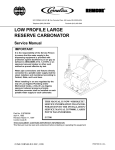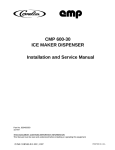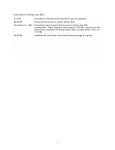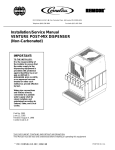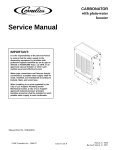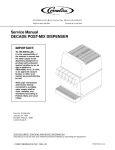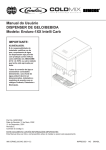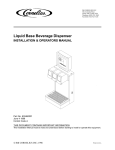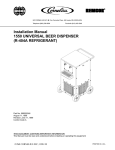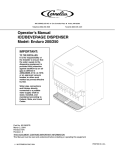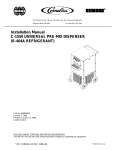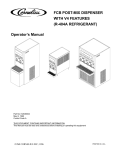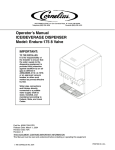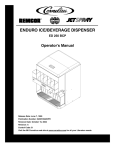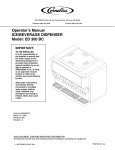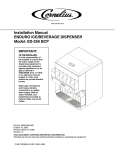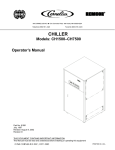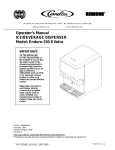Download Cornelius REMCOR R-134A User's Manual
Transcript
IMI CORNELIUS INC g One Cornelius Place g Anoka, MN 55303-6234 Telephone (800) 238-3600 Facsimile (612) 422-3246 Operator’s Manual SENTRY III-A POST-MIX COOLING UNIT (R-134A Refrigerant) Part No. 312021002 December 16, 1994 Revised: December 1, 1995 Control Code A THIS DOCUMENT CONTAINS IMPORTANT INFORMATION This Manual must be read and understood before installing or operating this equipment Ó IMI CORNELIUS INC; 1994--95 PRINTED IN U.S.A TABLE OF CONTENTS Page SAFETY INFORMATION . . . . . . . . . . . . . . . . . . . . . . . . . . . . . . . . . . . . . . . . . . . . . . . . . . . . 1 RECOGNIZE SAFETY INFORMATION . . . . . . . . . . . . . . . . . . . . . . . . . . . . . . . UNDERSTAND SIGNAL WORDS . . . . . . . . . . . . . . . . . . . . . . . . . . . . . . . . . . . . 1 1 FOLLOW SAFETY INSTRUCTIONS . . . . . . . . . . . . . . . . . . . . . . . . . . . . . . . . . CO2 (CARBON DIOXIDE) WARNING . . . . . . . . . . . . . . . . . . . . . . . . . . . . . . . . SHIPPING, STORING, OR RELOCATING UNIT . . . . . . . . . . . . . . . . . . . . . . . GENERAL INFORMATION . . . . . . . . . . . . . . . . . . . . . . . . . . . . . . . . . . . . . . . . . . . . . . . . . . 1 1 1 3 CLAIMS INSTRUCTIONS . . . . . . . . . . . . . . . . . . . . . . . . . . . . . . . . . . . . . . . . . . . . . . . WARRANTY REFERENCE INFORMATION . . . . . . . . . . . . . . . . . . . . . . . . . . . . . . . DESIGN DATA . . . . . . . . . . . . . . . . . . . . . . . . . . . . . . . . . . . . . . . . . . . . . . . . . . . . . . . . 3 3 3 DESCRIPTION . . . . . . . . . . . . . . . . . . . . . . . . . . . . . . . . . . . . . . . . . . . . . . . . . . . . . . . . THEORY OF OPERATION . . . . . . . . . . . . . . . . . . . . . . . . . . . . . . . . . . . . . . . . . . . . . . PARTS IDENTIFICATION . . . . . . . . . . . . . . . . . . . . . . . . . . . . . . . . . . . . . . . . . . . . . . . . . . . 4 5 7 OWNER’S RECOMMENDED MAINTENANCE . . . . . . . . . . . . . . . . . . . . . . . . . . . . . . . . . 9 OPERATORS INSTRUCTIONS . . . . . . . . . . . . . . . . . . . . . . . . . . . . . . . . . . . . . . . . . . . . . . 11 OPERATING CONTROLS . . . . . . . . . . . . . . . . . . . . . . . . . . . . . . . . . . . . . . . . . . . . . . COOLING UNIT POWER SWITCH . . . . . . . . . . . . . . . . . . . . . . . . . . . . . . . . . . COOLING UNIT CIRCULATING PUMP POWER SWITCH . . . . . . . . . . . . . . COOLING UNIT CARBONATOR MOTOR POWER SWITCH . . . . . . . . . . . . 11 11 11 11 DAILY PRE-OPERATION CHECK . . . . . . . . . . . . . . . . . . . . . . . . . . . . . . . . . . . . . . . . GENERAL MAINTENANCE . . . . . . . . . . . . . . . . . . . . . . . . . . . . . . . . . . . . . . . . . . . . . . . . . 11 13 ADJUSTMENTS . . . . . . . . . . . . . . . . . . . . . . . . . . . . . . . . . . . . . . . . . . . . . . . . . . . . . . . ADJUSTING CO2 REGULATORS . . . . . . . . . . . . . . . . . . . . . . . . . . . . . . . . . . . ADJUSTING CARBONATOR WATER TANK LIQUID LEVEL . . . . . . . . . . . . SANITIZING SYRUP SYSTEMS . . . . . . . . . . . . . . . . . . . . . . . . . . . . . . . . . . . . . . . . . CHECKING ICE WATER BATH . . . . . . . . . . . . . . . . . . . . . . . . . . . . . . . . . . . . . . . . . . 13 13 13 13 13 CLEANING CONDENSER COIL . . . . . . . . . . . . . . . . . . . . . . . . . . . . . . . . . . . . . . . . . CARBONATOR WATER PUMP MAINTENANCE (OR AFTER WATER SYSTEM DISRUPTION) . . . . . . . . . . . . . . . . . . . . . . . . . . . . . . . . . . . . . . . . . . . . . . . . REPLENISHING CO2 SUPPLY . . . . . . . . . . . . . . . . . . . . . . . . . . . . . . . . . . . . . . . . . . REPLENISHING SYRUP SUPPLY . . . . . . . . . . . . . . . . . . . . . . . . . . . . . . . . . . . . . . . PERIODIC CLEANING OF COOLING UNIT . . . . . . . . . . . . . . . . . . . . . . . . . . . . . . . CLEANING AND SANITIZING . . . . . . . . . . . . . . . . . . . . . . . . . . . . . . . . . . . . . . . . . . . 14 DAILY CLEANING OF UNIT . . . . . . . . . . . . . . . . . . . . . . . . . . . . . . . . . . . . . . . . SANITIZING POST-MIX SYRUP SYSTEMS . . . . . . . . . . . . . . . . . . . . . . . . . . TROUBLESHOOTING . . . . . . . . . . . . . . . . . . . . . . . . . . . . . . . . . . . . . . . . . . . . . . . . . . . . . . 15 15 19 DISPENSED PRODUCT CARBONATION TOO LOW. . . . . . . . . . . . . . . . . . . . . . . ONLY SYRUP DISPENSED. . . . . . . . . . . . . . . . . . . . . . . . . . . . . . . . . . . . . . . . . . . . . WARM PRODUCT BEING DISPENSED . . . . . . . . . . . . . . . . . . . . . . . . . . . . . . . . . . WATER PUMP WILL NOT OPERATE . . . . . . . . . . . . . . . . . . . . . . . . . . . . . . . . . . . . 19 19 19 19 WATER PUMP MOTOR OPERATES BUT WATER PUMP DOES NOT PUMP WATER. . . . . . . . . . . . . . . . . . . . . . . . . . . . . . . . . . . . . . . . . . . . . . . . . . . . . . . . . . . . . . . WATER PUMP CAPACITY TOO LOW. . . . . . . . . . . . . . . . . . . . . . . . . . . . . . . . . . . . 19 19 i 14 14 15 15 15 312021002 TABLE OF CONTENTS (cont’d) Page COMPRESSOR DOES NOT OPERATE. . . . . . . . . . . . . . . . . . . . . . . . . . . . . . . . . . . COMPRESSOR OPERATES CONTINUOUSLY BUT DOES NOT FORM SUFFICIENT ICE BANK. . . . . . . . . . . . . . . . . . . . . . . . . . . . . . . . . . . . . . . . . . . . . . . . WARRANTY . . . . . . . . . . . . . . . . . . . . . . . . . . . . . . . . . . . . . . . . . . . . . . . . . . . . . . . . . . . . . . 20 20 21 LIST OF FIGURES FIGURE 1. SENTRY III-A COOLING UNIT . . . . . . . . . . . . . . . . . . . . . . . . . . . . . . . . FIGURE 2. SYSTEM FLOW DIAGRAM . . . . . . . . . . . . . . . . . . . . . . . . . . . . . . . . . . . FIGURE 3. PARTS IDENTIFICATION . . . . . . . . . . . . . . . . . . . . . . . . . . . . . . . . . . . . 5 6 7 LIST OF TABLES TABLE 1. DESIGN DATA . . . . . . . . . . . . . . . . . . . . . . . . . . . . . . . . . . . . . . . . . . . . . . . 312021002 ii 3 SAFETY INFORMATION Recognize Safety Information This is the safety-alert symbol. When you see this symbol on our machine or in this manual, be alert to the possibility of personal injury. Follow recommended precautions and safe operating practices. Understand Signal Words A signal word - DANGER, WARNING, OR CAUTION is used with the safety-alert symbol. DANGER identifies the most serious hazards. Safety signs with signal word DANGER or WARNING are typically near specific hazards. General precautions are listed on CAUTION safety signs. CAUTION also calls attention to safety messages in this manual. DANGER WARNING CAUTION Follow Safety Instructions Carefully read all safety messages in this manual and on your machine safety signs. Keep safety signs in good condition. Replace missing or damaged safety signs. Learn how to operate the machine and how to use the controls properly. Do not let anyone operate the machine without instructions. Keep your machine in proper working condition. Unauthorized modifications to the machine may impair function, safety, and affect the machine life and may void the factory warranty. CO2 (Carbon Dioxide) Warning CO2 Displaces Oxygen. Strict Attention must be observed in the prevention of CO2 (carbon dioxide) gas leaks in the entire CO2 and soft drink system. If a CO2 gas leak is suspected, particularly in a small area, immediately ventilate the contaminated area before attempting to repair the leak. Personnel exposed to high concentration of CO2 gas will experience tremors which are followed rapidly by loss of consciousness and suffocation. Shipping, Storing, Or Relocating Unit CAUTION: All water must be purged from the Unit if exposed to freezing temperature. A freezing ambient temperature will cause residual water remaining inside the Unit to freeze resulting in damage to internal components of the Unit. 1 312021002 THIS PAGE LEFT BLANK INTENTIONALLY 312021002 2 GENERAL INFORMATION CLAIMS INSTRUCTIONS Claims: In the event of shortage, notify the carrier as well as IMI Cornelius Inc. immediately. In the event of damage, notify the carrier. IMI Cornelius Inc. is not responsible for damage, occurring in transit, but will gladly render assistance necessary to pursue your claim. Merchandise must be inspected for concealed damage within 15 days of receipt. WARRANTY REFERENCE INFORMATION (to be filled out by customer) Unit Part Number Serial Number Install Date: Local Authorized Service Center DESIGN DATA Table 1. Design Data Unit Part Numbers: Domestic Unit 4164920000 Export Unit 4964920000 COOLING UNIT DATA Cooling Unit Overall Dimensions: (with hood in place) Height 36-- 1/4 inches Width 19 inches Depth 27 inches NOTE: Cooling unit Stand P/N 309802069 (optional) with cooling unit in place on stand dimensions: Height (approx) 74-- 1/4 inches Width 36 inches Depth 19-- 1/2 inches Weights: (approximate) Shipping Weight 260 pounds Weight (W/O Cartoning) 240 pounds Capacities: Cooling Unit Water Bath (no ice bank) 16.8 gallons 3 312021002 Table 1. Design Data (cont’d) Ambient Operating Temperature 40°F to 100°F Electrical Requirements: See Unit Nameplate DROP--IN REFRIGERATION ASSEMBLY DATA Weights: No Ice Bank 103 pounds With Ice Bank 142 pounds Refrigerant Requirement (R-134A Refrigerant) See Unit Nameplate DESCRIPTION IMPORTANT: To the user of this manual - This manual is a guide for installing, operating, and maintaining this equipment. Refer to the Table of Contents for page location for detailed information pertaining to questions that arise during installation, operation, service, or maintenance of this equipment. CAUTION: Before shipping, storing, or relocating this Unit, the syrup systems must be sanitized and all sanitizing solution must be purged from the syrup systems. All water must also be purged from the plain and carbonated water systems. A freezing ambient environment will cause residual water in the Unit to freeze resulting in damage to internal components. WARNING: CO2 displaces oxygen. Strict attention must be observed in the prevention of CO2 (carbon dioxide) gas leaks in the entire CO2 and soft drink system. If a CO2 gas leak is suspected, particularly in a small area, immediately ventilate the contaminated area before attempting to repair the leak. Personnel exposed to high concentration of CO2 gas will experience tremors which are followed rapidly by loss of consciousness and suffocation. The Sentry III-A Post--Mix Cooling Unit with R-134A Refrigerant (see Figure 1) is designed to provide cooled syrup, carbonated water, and plain water to the dispensing station(s) connected to the cooling unit through an insulated python (length as ordered). The lower cabinet of the Cooling Unit consist of carbonated water, plain water, and syrup coils located in the water tank, a carbonator, and a carbonated water circulating pump. The Cooling Unit utilizes a drop--in refrigeration assembly which contains the refrigeration compressor and a condenser coil and fan assembly as shown in Figure 3 An optional Cooling Unit Stand (P/N 309802069) is available to elevate the Cooling Unit up off the floor. 312021002 4 FIGURE 1. SENTRY III-A COOLING UNIT THEORY OF OPERATION (see Figure 2) A CO2 cylinder delivers carbon dioxide gas (CO2) through adjustable CO2 regulators to the soft drink tanks and also to the built--in carbonator located inside the Cooling Unit. Plain water is pumped into the carbonated water tank by the water pump and is carbonated by regulated CO2 pressure also entering the tank. When dispensing valve is opened, CO2 pressure exerted upon the syrup in the soft drink tank pushes syrup from the tank, through the Cooling Unit cooling coils, through the python and on to the dispensing valve. Carbonated water is pushed by CO2 pressure from the carbonated water tank, through the Cooling Unit cooling coils, through the python and on to the dispensing valve. Syrup and carbonated water meet at the dispensing valve resulting in a carbonated drink being dispensed. Plain water is also available at the dispensing station by passing through the Cooling Unit cooling coils, through the python, and on to the dispensing station. Carbonated water is replenished when carbonated water level inside the carbonator tank drops to a specified level which in turn automatically starts the carbonator water pump motor. When carbonated water level inside the carbonated water tank has been replenished, carbonator water pump motor will stop. Carbonated water is continuously being circulated from the Cooling Unit, out through the insulated python to the dispensing station(s), and back to the cooling unit which maintains liquids in the python at a cold temperature. 5 312021002 312021002 6 PYTHON LINES 1THROUGH 5 and 9 SYRUP 6 PLAIN WATER 7 CARB WATER OUT UNNUMBERED LINE IS CARB WATER RETURN BARBED CONNECTORS (9) 9-LINE PYTHON TO DISPENSING TOWER LINE LEGEND PLAIN WATER CARB WATER CO2 SYRUP CARBONATED WATER TANK SHUTOFF VALVE FIGURE 2. SYSTEM FLOW DIAGRAM CARBONATED WATER CIRCULATING PUMP DOUBLE LIQUID CHECK VALVE COOLING UNIT CARBONATED WATER PUMP PLAIN WATER INLET CONNECTION CO2 INLET CONNECTION SYRUP INLET CONNECTIONS PARTS IDENTIFICATION HOOD RETAINING ACORN NUT CONTROL BOX COMPRESSOR *CONDENSER COIL AIR FILTER HOOD WATER FILL HOLE CONDENSER COIL CARBONATOR MOTOR POWER SWITCH CONDENSER FAN MOTOR CIRCULATING MOTOR POWER SWITCH CARBONATED WATER CIRCULATING PUMP MOTOR AGITATOR MOTOR COOLING UNIT POWER SWITCH SHIPPING NUT (4) UNIT ELECTRICAL BOX SYRUP INLET LINES ACCESS PANEL RETAINING SCREW (4) CO2 GAS INLET PLAIN WATER INLET OUTLET LINES LOWER ACCESS GRILLE CARBONATOR WATER PUMP MOTOR CARBONATED WATER TANK CARBONATOR WATER PUMP SAFETY THERMOSTAT CARBONATOR WATER PUMP CAUTION: The refrigeration assembly condenser coil and air filter must be cleaned every 30 days. Excessive accumulation of dust, lint, and grease on air filter and coil will restrict cooling air flow through the coil and cause coil and refrigeration system to overheat. Operating refrigeration system in an overheated condition will eventually lead to compressor failure. FIGURE 3. PARTS IDENTIFICATION 7 312021002 THIS PAGE LEFT BLANK INTENTIONALLY 312021002 8 OWNER’S RECOMMENDED MAINTENANCE Maintenance Schedule Task D M Q A 1. Make sure CO2 cylinder regulator assembly O 1800--psi gage indicator is not in shaded (‘‘change CO2 cylinder’’) portion of dial. If so, CO2 cylinder is almost empty and must be replaced. 2. CO2 regulators should be checked for proper pres- S 3. The carbonator tank liquid level (40 to 60-ounces) S sure settings periodically and adjusted as instructed. pump cut--in and cut--out were adjusted at the factory and should require no further adjustment. If incorrect adjustment is suspected, call a Service Person. 4. Syrup systems should be sanitized every 90-days S following Sanitizer Manufacturer’s recommendations as instructed in this manual. 5. Ice water bath should be checked periodically as O instructed to make sure correct water is maintained in water tank for maximum cooling. 6. The drop--in refrigeration assembly condenser coil is O equipped with a washable air filter that must be cleaned every 30-days as instructed . 7. Carbonator water pump motor and carbonated wa- S ter circulating pump motor bearings must be oiled as instructed in Service Manual (P/N 312021004). 8. Carbonator water pump water inlet strainer screen S and double liquid check valve must be inspected and cleaned at least once a year under normal circumstances and after any water system disruption (plumbing work, earthquake, etc.). 9. Clean and service Cooling Unit CO2 gas inlet check S valve. The CO2 gas check valve must be inspected and serviced at least once a year under normal conditions and after any CO2 system servicing or disruption as instructed in Service Manual (P/N 312021004) Legend: Daily Operator Weekly Monthly Service Person 9 Quarterly Annually 312021002 THIS PAGE LEFT BLANK INTENTIONALLY 312021002 10 OPERATORS INSTRUCTIONS This section covers operating controls, daily pre-operation check, adjustments, replenishing CO2 and syrup supplies, and general maintenance to be performed by the Operator on the Cooling Unit. WARNING: Disconnect electrical power from the Cooling Unit to prevent personal injury before attempting any internal maintenance. Only qualified personnel should service internal components or electrical wiring. OPERATING CONTROLS (see Figure 3) COOLING UNIT POWER SWITCH Cooling Unit power switch, located on syrup inlet line connection side of the unit, must be in the “ON”(up) position before the unit will operate. COOLING UNIT CIRCULATING PUMP POWER SWITCH Carbonated water circulating pump power switch labeled CIRC MOTOR, located on electrical box under hood, must be in “ON”(up) position before motor will operate. COOLING UNIT CARBONATOR MOTOR POWER SWITCH Carbonator motor power power switch labeled CARB MOTOR, located on electrical box under hood, must be in “ON”(up) position before carbonator will operate. DAILY PRE-OPERATION CHECK 1. Make sure CO2 cylinder primary CO2 regulator assembly 1800-psi gage indicator is not in shaded (“change CO2 cylinder”) portion of the dial. If so, CO2 cylinder is almost empty and must be replaced as instructed. 2. Sufficient syrup supply in all syrup tanks. If not, replenish syrup supply as instructed. 11 312021002 THIS PAGE LEFT BLANK INTENTIONALLY 312021002 12 GENERAL MAINTENANCE ADJUSTMENTS ADJUSTING CO2 REGULATORS The Operator must first check the CO2 supply to make sure it is adequate. Determine by looking at the CO2 cylinder primary CO2 regulator assembly 1800-psi gage as described in “Daily Pre-Operation Check”. Ranges for adjusting CO2 regulators are as follows: 80-psi minimum to a maximum of 125-psi for the carbonator primary CO2 regulator, 55 to 60-psi for sugar syrup tanks CO2 regulator, and 12-psi for diet syrup tank CO2 regulator. Refer to step 2 of “Maintenance Schedule”. ADJUSTING CARBONATOR WATER TANK LIQUID LEVEL The carbonator water tank liquid level (40 to 60-ounces) pump cut-in and cut-out were adjusted at the factory and should require no further adjustment. If incorrect adjustment is suspected, check and make necessary adjustments as instructed in Service Manual (P/N 312021-004). Refer to step 3 of “Maintenance Schedule”. SANITIZING SYRUP SYSTEMS The syrup systems should be sanitized every 90-days as instructed in this manual. Refer to step 4 of “Maintenance Schedule”. CHECKING ICE WATER BATH (see Figure 3 A gurgle heard from the Cooling Unit indicates water level in the water tank is low and more water should be added for maximum cooling. Before adding more water to the tank, ice water bath and ice bank should be checked for cleanliness and water tank coils checked for excessive mineral deposit build-up. If necessary to clean the water tank, call a Service Person to perform the cleaning procedure. Refer to step 5 of “Maintenance Schedule”. Add more water to the water tank as follows: 1. Place Cooling Unit power switch in “OFF”(down) position. 2. Remove top screw from ground strap securing hood to Cooling Unit. 3. Remove acorn nut securing hood on Unit, then lift hood straight up to remove. 4. Remove plug from drop-in refrigeration assembly water fill hole. 5. Using flashlight, inspect ice water bath and ice bank for cleanliness. Ice water bath should be clear and ice bank free of foreign particles. 6. If cleaning of water tank is necessary, call a Service Person to perform the cleaning procedure. 7. Fill water tank with clean water until water runs out of the water tank overflow tube. USE LOW-MINERALCONTENT WATER WHERE A LOCAL WATER PROBLEM EXIST. 8. Install plug in water fill hole. 9. Install Cooling Unit hood and secure with acorn nut. 10. Install screw in hood ground strap to secure strap to hood. 13 312021002 11. Place Cooling Unit power switch in “ON”(up) position. CLEANING CONDENSER COIL (see Figure 3 CAUTION: The drop-in refrigeration assembly condenser coil and air filter must be cleaned every 30-days. Excessive accumulation of dust, lint, and grease on the air filter and coil will restrict air flow through the coil and cause refrigeration assembly to overheat. Operating refrigeration system in an overheated condition will eventually lead to refrigeration compressor failure. Area on top of hood must be kept free of obstructions at all times. Make sure nothing is stored on top of the hood. Clean condenser coil and air filter as follows: 1. Place Cooling Unit power switch in “OFF”(down) position. 2. Remove top screw from ground strap securing hood to Cooling Unit. 3. Remove acorn nut securing hood on Unit, then lift hood straight up to remove. 4. Slide air filter straight up out of the condenser coil frame side rails to remove. 5. Wash out air filter with water and detergent solution, the rinse with clean water and allow to air dry. 6. Vacuum or use a soft brush to clean condenser coil. If available, use low-pressure compressed air. 7. Clean dust and dirt from around top of the refrigeration assembly. 8. Install air filter on condenser coil by reversing removal procedure. 9. Install Cooling Unit hood and secure with acorn nut. 10. Install screw in hood ground strap to secure strap to hood. 11. Place Cooling Unit power switch in “ON”(up) position. CARBONATOR WATER PUMP MAINTENANCE (OR AFTER WATER SYSTEM DISRUPTION) WARNING: The carbonator water pump water inlet strainer screen and double check valve must be inspected and serviced at least once a year under normal circumstances, and after any disruptions (plumbing work, earthquake, etc.) to the water supply system that might cause turbulent (erratic) flow of water through the system. A carbonator water pump with no screen or a defective screen in the strainer would allow foreign particles to foul the double check valve. CO2 gas could then back flow into the water system and create a health hazard in the water system. The carbonator water pump water inlet strainer screen and double liquid check valve must be inspected and serviced at least once a year as described in WARNING note above. This procedure should be performed by a Service Person. Refer to step 8 of “Maintenance Schedule”. REPLENISHING CO2 SUPPLY WARNING: CO2 displaces oxygen. Strict attention must be observed in the prevention of CO2 (carbon dioxide) gas leaks in the entire CO2 and soft drink system. If a CO2 gas leak is suspected, particularly in a small area, immediately ventilate the contaminated area before attempting to repair the leak. Personnel exposed to high concentration of CO2 gas will experience tremors which are followed rapidly by loss of consciousness and suffocation. 312021002 14 1. Close empty CO2 cylinder shutoff valve, then remove empty cylinder. WARNING: To avoid personal injury and/or property damage, always secure CO2 cylinder in an upright position with a safety chain to prevent it from falling over. Should the valve become accidentally damaged or broken off, CO2 cylinder can cause personal injury. 2. Install full CO2 cylinder, the open shutoff valve. MAKE SURE CO2 CYLINDER IS POSITIONED IN UPRIGHT POSITION AND IS FASTENED WITH A SAFETY CHAIN. REPLENISHING SYRUP SUPPLY 1. Remove CO2 and syrup quick disconnects from empty syrup tank, then remove tank. 2. Place full syrup tank in position, then connect CO2 and syrup quick disconnects to tank. PERIODIC CLEANING OF COOLING UNIT Periodically wash all external surfaces of the Cooling Unit, rinse with clean water, then wipe the Cooling Unit dry with a clean soft cloth. DO NOT USE ABRASIVE CLEANERS. CLEANING AND SANITIZING DAILY CLEANING OF UNIT 1. Remove cup rest from the drip tray. 2. Wash drip tray in place on the Unit, then rinse drip tray with hot water allowing water to drain out through the drain hose. 3. Wash cup rest, then rinse the cup rest with clean water. Install cup rest in the drip tray. 4. Clean all external surfaces of the Unit with a sponge. Rinse out the sponge with clean water, then wring excess water out of the sponge and wipe off all external surfaces on the Unit. Wipe Unit dry with a clean soft cloth. DO NOT USE ABRASIVE CLEANERS. 5. Remove nozzle and syrup diffusers from the dispensing valves. Place nozzles and syrup diffusers in sanitizing solution. 6. Wash the nozzles and syrup diffusers in sanitizing solution, then rinse them with potable water. 7. Re-install nozzles and syrup diffusers back on the dispensing valves. SANITIZING POST-MIX SYRUP SYSTEMS IMPORTANT: Only qualified Service Personnel should perform sanitizing procedure on the post-mix syrup systems. The post-mix syrup systems should be sanitized every 90-days using a non-scented household liquid bleach containing a 5.25 % sodium hypochlorite concentration. Proceed as follows to sanitize the post-mix syrup systems. 1. Disconnect syrup supplies from syrup systems. 2. Rinse quick disconnects (syrup tanks systems) or bag-in-box connectors (syrup bag-in-box systems) in warm potable water. STEP 1. WASH SYRUP SYSTEMS 15 312021002 3. Using a clean syrup tank (syrup tank system) or a five-gallon container (bag-in-box system), prepare a full tank or container of liquid dishwasher detergent by using 70_F (21_C) to 100_F (38_C) potable water and 0.5 oz. (15 ml) of liquid dishwasher detergent to one gallon of potable water. Stir detergent solution to thoroughly mix the solution. 4. Syrup Tank Systems. A. Observe and note CO2 pressure setting on the syrup tanks CO2 regulator, then re-adjust CO2 regulator to 60 to 80-psi. Pressurize syrup tank containing detergent solution to 60 to 80-psi. B. Connect detergent solution tank, pressurized at 60 to 80-psi, into one of the syrup systems. Bag-in Box Syrup Systems. C. Install bag valves, cut from empty bag-in-box syrup containers, on ends of syrup containers syrup outlet tubes connectors. D. Place all syrup outlet tubes, with bag valves on their ends, in container containing detergent solution. 5. Flush the syrup system and dispensing valve as follows: A. Place waste container under applicable dispensing valve. B. Activate the dispensing valve for one minute to purge all syrup and flush out the syrup system. C. Continue to activate the dispensing valve in cycles (“ON”for 15-seconds, “OFF”, then “ON”for 15-seconds). Repeat “ON”and “OFF”cycles for 15-cycles. 6. Connect detergent solution to the remaining syrup systems and flush syrup out of the syrup systems as instructed in step 5 preceding. 7. Remove detergent solution source from the syrup system. STEP 2. FLUSH SYRUP SYSTEMS 8. Syrup Tank Systems. Connect syrup tank containing potable water, pressurized at 60 to 80-psi, into one of the syrup systems. Bag-in-Box Syrup System. Fill five-gallon container with potable water, then place all bag-in-box syrup containers syrup outlet tubes in container containing potable water. 9. Flush detergent solution out of the syrup system and dispensing valve as follows: A. Place waste container under applicable dispensing valve. B. Activate the dispensing valve for one minute to purge all detergent solution and flush out the syrup system. C. Continue to activate the dispensing valve in cycles (“ON”for 15-seconds, “OFF”, then “ON”for 15-seconds). Repeat “ON”and “OFF”cycles for 15-cycles. 10. Connect potable water source to the remaining syrup systems and flush detergent solution out of the syrup systems as instructed in step 9 preceding. 11. Remove potable water source from the syrup system. STEP 3. SANITIZE SYRUP SYSTEMS 12. Using a clean syrup tank (syrup tanks system) or a five-gallon container (bag-in-box system), prepare sanitizing solution using 70_F (21_C) to100_F (38_C) potable water and 0.5 oz. (15 ml) of non-scented household liquid bleach that contains a 5.25 % sodium hypochlorite concentration to one gallon of potable water. This mixture must not exceed 200 PPM of chlorine. Stir sanitizing solution to thoroughly mix. 312021002 16 13. Syrup Tank Systems. Connect sanitizing solution tank, pressurized at 60 to 80-psi, into one of the syrup systems. Bag-in-Box Syrup System. Place all bag-in-box syrup containers syrup outlet tubes in container containing sanitizing solution. 14. Sanitize the syrup system and dispensing valve as follows: A. Place waste container under applicable dispensing valve. B. Activate the dispensing valve for one minute to purge all water from and install sanitizing solution in the syrup system and dispensing valve. C. Continue to activate the dispensing valve in cycles (“ON”for 15-seconds, “OFF”, then “ON”for 15-seconds). Repeat “ON”and “OFF”cycles for 15-cycles. 15. Repeat steps13 and 14 to flush water out of and install sanitizing solution in the remaining syrup systems and dispensing valves. 16. Remove sanitizing solution source from the syrup system. 17. Allow sanitizing solution to remain in the syrup systems for not less than 10 or no more than 15-minutes (max.) contact time. STEP 4. WATER FLUSH SYRUP SYSTEMS WARNING: Flush sanitizing solution from the syrup systems as instructed. Residual sanitizing solution left in the syrup systems could create a health hazard. 18. Fill syrup tank (syrup tank system) or a five-gallon container (bag-in-box system) with potable water. 19. Syrup Tank Systems. Connect syrup tank containing potable water, pressurized at 60 to 80-psi, into one of the syrup systems. Bag-in-Box Syrup System. Place all bag-in-box syrup containers syrup outlet tubes in container containing potable water. 20. Flush sanitizing solution from the syrup system and the dispensing valve as follows: A. Place waste container under applicable dispensing valve. B. Activate the dispensing valve for one minute to purge all sanitizing solution out of the syrup system and the dispensing valve. C. Continue to activate the dispensing valve in cycles (“ON”for 15-seconds, “OFF”, then “ON”for 15-seconds). Repeat “ON”and “OFF”cycles for 15-cycles. 21. Repeat steps 19 and 20 preceding to purge sanitizing solution out of the remaining syrup systems and dispensing valves. 22. Remove potable water source from the syrup system. STEP 5. PURGE WATER OUT OF SYRUP SYSTEMS (RESTORE OPERATION) 23. Syrup Tank Systems. A. Noting syrup tanks CO2 regulator pressure setting observed in step 4 preceding, readjust CO2 regulator to the observed pressure setting, B. Connect tanks containing syrup into syrup systems. 17 312021002 Bag-in-Box Syrup System. C. Remove all bag valves from bag-in-box syrup containers outlet tubes connectors. D. Connect bag-in-box syrup containers into the syrup systems. 24. Place waste container under dispensing valves. Dispense from all dispensing valves to permit syrup to purge all potable water from the syrup systems and the dispensing valves. Continue to dispense from the dispensing valves until only syrup is dispensed from the syrup systems and valves. WARNING: To avoid possible personal injury or property damage, do not attempt to remove the syrup tank cover until CO2 pressure has been released from the tank. 25. Dispose of waste sanitizing solution in a sanitary sewer, not in a storm drain, then thoroughly rinse the inside and the outside of the container that was used for sanitizing solution to remove all sanitizing solution residue. 312021002 18 TROUBLESHOOTING IMPORTANT: Only qualified personnel should service internal components or electrical wiring. WARNING: If repairs are to be made to carbonated water system, disconnect electrical power to Cooling Unit, shut off plain water and CO2 supplies, and relieve the carbonated water system pressure before proceeding. If repairs are to be made to syrup system, remove quick disconnects from applicable syrup tank, then relieve the system pressure before proceeding. If repairs are to be made to CO2 system, stop dispensing, shut off CO2 supply, then relieve the system pressure before proceeding. TROUBLESHOOTING SENTRY III--A POST--MIX COOLING UNIT Trouble DISPENSED PRODUCT CARBONATION TOO LOW. ONLY SYRUP DISPENSED. WARM PRODUCT BEING DISPENSED Probable Cause Remedy A. Carbonator CO2 regulator out of adjustment for existing water conditions or temperature. A. Adjust carbonator CO2 regulator as instructed. B. Water, oil, or dirt in CO2 supply B. Remove contaminated CO2 supply. Clean CO2 system (lines, regulators,etc.) using a mild detergent. Replenish with a clean CO2 supply. A. Plain water inlet supply line shutoff valve closed. A. Open plain water inlet supply line shutoff valve. B. Carbonator power switch in ‘‘OFF’’position. B. Place carbonator power switch in ‘‘ON’’position. C. Carbonator inoperable. C. Call Service Person. D. Water filter clogged. D. Replace water filter. A. Carbonated water circulating pump power switch in “OFF” position. A. Place circulating pump power switch in “ON”position. B. Inoperable carbonated water circulating pump or motor. B. Call Service Person. TROUBLESHOOTING CARBONATOR WATER PUMP WILL NOT OPERATE WATER PUMP MOTOR OPERATES BUT WATER PUMP DOES NOT PUMP WATER. WATER PUMP CAPACITY TOO LOW. A. Carbonator power switch in “OFF”position. A. Place switch in “ON”position. B. Inoperative water pump motor. B. Call Service Person. A. Water pump water inlet strainer screen dirty. A. Call Service Person. B. Kinked water supply line. B. Straighten water supply line. C. Water pump worn out. C. Call Service Person A. Water pump water inlet strainer screen dirty. A. Call Service Person B. Water supply capacity too low. B. Inlet water supply must be at a minimum of 150--gallons per hour with a maximum water pressure of 70--psi. 19 312021002 Trouble WATER PUMP CAPACITY TOO LOW.(CONT’D) Probable Cause Remedy C. Water filter clogged. C. Replace water filter cartridge as instructed. D. Inoperative water pump. D. Call Service Person TROUBLESHOOTING REFRIGERATION SYSTEM Trouble COMPRESSOR DOES NOT OPERATE. COMPRESSOR OPERATES CONTINUOUSLY BUT DOES NOT FORM SUFFICIENT ICE BANK. 312021002 Probable Cause Remedy A. Ice bank sufficient. A. Refrigeration not called for B. Electrical power to cooling unit turned off. B. Turn on electrical power to Cooling Unit. C. No cooling unit power source. Blown fuse or tripped circuit breaker. C. Replace fuse or reset circuit breaker. D. Inoperative compressor. D. Call Service Person. A. Cooling capacity is exceeded by overdrawing. A. Reduce amount of drinks drawn per given time. B. Cooling unit located in excessively hot area or air circulation through condenser coil is restricted B. Relocate unit or check and if necessary, clean condenser coil as instructed. 20 WARRANTY IMI Cornelius Inc. warrants that all equipment and parts are free from defects in material and workmanship under normal use and service. For a copy of the warranty applicable to your Cornelius, Remcor or Wilshire product, in your country, please write, fax or telephone the IMI Cornelius office nearest you. Please provide the equipment model number, serial number and the date of purchase. IMI Cornelius Offices AUSTRALIA D P.O. 210, D RIVERWOOD, D NSW 2210, AUSTRALIA D (61) 2 533 3122 D FAX (61) 2 534 2166 AUSTRIA D AM LANGEN FELDE 32 D A-1222 D VIENNA, AUSTRIA D (43) 1 233 520 D FAX (43) 1-2335-2930 BELGIUM D BOSKAPELLEI 122 D B-2930 BRAASCHAAT, BELGIUM D (32) 3 664 0552 D FAX (32) 3 665 2307 BRAZIL D RUA ITAOCARA 97 D TOMAS COELHO D RIO DE JANEIRO, BRAZIL D (55) 21 591 7150 D FAX (55) 21 593 1829 ENGLAND D TYTHING ROAD ALCESTER D WARWICKSHIRE, B49 6 EU, ENGLAND D (44) 789 763 101 D FAX (44) 789 763 644 FRANCE D 71 ROUTE DE ST. DENIS D F-95170 DEUIL LA BARRE D PARIS, FRANCE D (33) 1 34 28 6200 D FAX (33) 1 34 28 6201 GERMANY D CARL LEVERKUS STRASSE 15 D D-4018 LANGENFELD, GERMANY D (49) 2173 7930 D FAX (49) 2173 77 438 GREECE D 488 MESSOGION AVENUE D AGIA PARASKEVI D 153 42 D ATHENS, GREECE D (30) 1 600 1073 D FAX (30) 1 601 2491 HONG KONG D 1104 TAIKOTSUI CENTRE D 11-15 KOK CHEUNG ST D TAIKOKTSUE, HONG KONG D (852) 789 9882 D FAX (852) 391 6222 ITALY D VIA PELLIZZARI 11 D 1-20059 D VIMARCATE, ITALY D (39) 39 608 0817 D FAX (39) 39 608 0814 NEW ZEALAND D 20 LANSFORD CRES. D P.O. BOX 19-044 AVONDALE D AUCKLAND 7, NEW ZEALAND D (64) 9 8200 357 D FAX (64) 9 8200 361 SINGAPORE D 16 TUAS STREET D SINGAPORE 2263 D (65) 862 5542 D FAX (65) 862 5604 SPAIN D POLIGONO INDUSTRAIL D RIERA DEL FONOLLAR D E-08830 SANT BOI DE LLOBREGAT D BARCELONA, SPAIN D (34) 3 640 2839 D FAX (34) 3 654 3379 USA D ONE CORNELIUS PLACE D ANOKA, MINNESOTA D (612) 421-6120 D FAX (612) 422-3255 LD004 4/21/98 21 312021002 IMI CORNELIUS INC. CORPORATE HEADQUARTERS: One Cornelius Place Anoka, Minnesota 55303-6234 (612) 421-6120 (800) 238-3600


























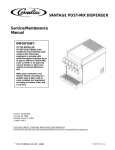
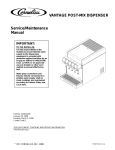
![Service Manual VA13 Carbonator [ 002818 ]](http://vs1.manualzilla.com/store/data/006013608_1-0f8f87056a0ab013b1dd01dac3912d47-150x150.png)
